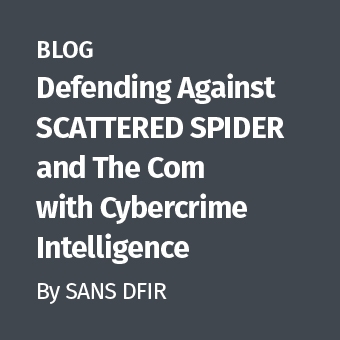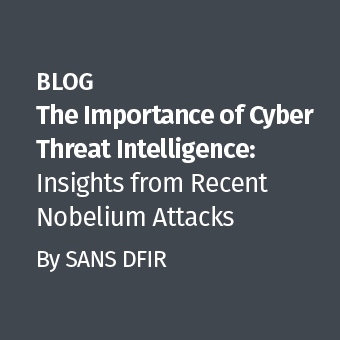Threat feeds in the industry are a valuable way to gather information regarding adversaries and their capabilities and infrastructure. Threat feeds are usually not intelligence though. Unfortunately, one of the reasons many folks become cynical about threat intelligence is because the industry has pushed terminology that is inaccurate and treated threat intelligence as a solution to all problems. In a talk I gave at the DFIR Summit in Austin, Texas I compared most of today's threat intelligence to Disney characters — because both are magical and made up.
When security personnel understand what threat intelligence is, when they are ready to use it, and how to incorporate it into their security operations it becomes very powerful. Doing all of that requires a serious security maturity in an organization. The biggest issue in the industry currently is the labeling of data and information as intelligence and the discussion of tools producing intelligence.

One of the commonly referenced works when discussing intelligence is the U.S. Department of Defense's Joint Publication 2-0: Joint Intelligence. Intelligence has been around a lot longer than the word ?cyber' and it's important to look to these kinds of sources to gather important context and understanding of the world of intelligence. One of the graphics (Figure 1) presented in the publication shows the relationship of data, information, and intelligence. If the cyber threat intelligence community writ large understood this single concept it would drive a much better discussion than what is sometimes pushed through marketing channels.
Every organization has an operational environment. The physical location of the organization, the networked infrastructure they use, the interconnections they have with other networks, and their accessibility to and from the Internet are all portions of their operational environment. This operational environment contains more data than could ever be fully collected. Many organizations have difficulty collecting and retaining packet capture for their environment more than a few days (if at all) let alone all of the data. So collection efforts are often driven by tools that can reach into the operational environment and get data. On limited resources it usually takes analysts understanding where the most critical data is located and to collect it using the best tools available. Tools are required to make the most out of data collection efforts. The data in this form is raw.
This raw data is then processed and exploited into a more usable form. As an example, the packet capture that is run against an intrusion detection system generates information in the form of an alert. There should be more data than information. The information may have a sample of the data, such as the portion of the packet capture that matched the alert, and it is made available to the analyst with some context even if only "this packet matched a signature thought to be malicious". Information can give you a yes or no answer. Another example would be an antivirus match against malware on a system. The raw data, the malware's code, is matched against a signature in the antivirus system to generate an alert. This alert is information. It answers the question "is malware present on the system". The answer could be incorrect, maybe the match was a false positive, but it still answered a yes or no question of interest. Tools are not required to make information but it is very inefficient to create information without tools. Most vendor tools that make claims of producing "threat intelligence" are actually producing threat information. It is extremely valuable and necessary for making the most of analysts' time — but it is not intelligence.
Various sources of information that are analyzed together to make an assessment produce intelligence. Intelligence will never answer a yes or no question. The nature of doing intelligence analysis means that there will only be an assessment. As an example, if an intelligence analyst takes a satellite photo and notices tanks on the border of Crimea they can generate information that states that the tanks are on the border. It answers a yes or no question. If the intelligence analyst takes this source of information and combines it with other sources of information such as geopolitical information, statements from political leaders, and more they could then make an assessment that they state with low, medium, or high confidence that an invasion of Crimea is about to take place. It is impossible to know the answer for sure — there cannot be a yes or no — but the analysis created an intelligence product that is useful to decision makers. There should also be far more information than intelligence; intelligence is a refined product and process. In the cyber field we would make intelligence assessments of adversaries, their intent, potential attribution, capabilities they may be seeking, or even factors such as their opportunity and probability of attacking a victim. The intelligence can produce useful knowledge such as the tactics, techniques, and procedures of the adversary. The intelligence can even be used for different audiences which usually gets broken into strategic, operational, or tactical level threat intelligence. But it is important to understand that no tool can produce intelligence. Intelligence is only created by analysts. The analysis of various sources of information requires understanding the intelligence needs, analysis of competing hypotheses, and subject matter expertise.
By understanding the difference between data, information, and intelligence security personnel can make informed decisions on what they are actually looking for to help with a problem they face. Do you just want to know if the computer is infected? Threat information is needed. Do you just want raw data related to various threats out there? Threat data is needed. Or do you want a refined product that makes assessments about the threat to satisfy an audience's defined needs? That requires Threat intelligence. This understanding helps the community identify what tools they should be acquiring and using for those problems. It helps guide collection processes, the types of training needed for security teams, how the security teams are going to respond, and more.
There is no such thing as threat intelligence data, there are no tools that create intelligence, and there is limited value for organizations that do not understand their operational environment to invest in threat intelligence. But when an organization understands the difference between data, information, and intelligence and understands their environment to be able to identify what constitutes a threat to them then threat intelligence is an extremely useful addition to security. I am a big believer in cyber threat intelligence when it is done correctly. It's why I worked with Mike Cloppert and Chris Sperry to co-author SANS578 — Cyber Threat Intelligence. It is unlikely though that your threat feed is really threat intelligence. But it may be exactly what you're looking for; know the difference so that you can save your organization time and money while contributing to security.
*Edit* I edited the title to add the word "likely". Rick Holland pointed out that there are a few rare exceptions in the industry today that an organization is putting out a feed derived from a real intelligence product. It does not reflect the industry as a whole today but it is possible to have a feed that is based on real intelligence.





